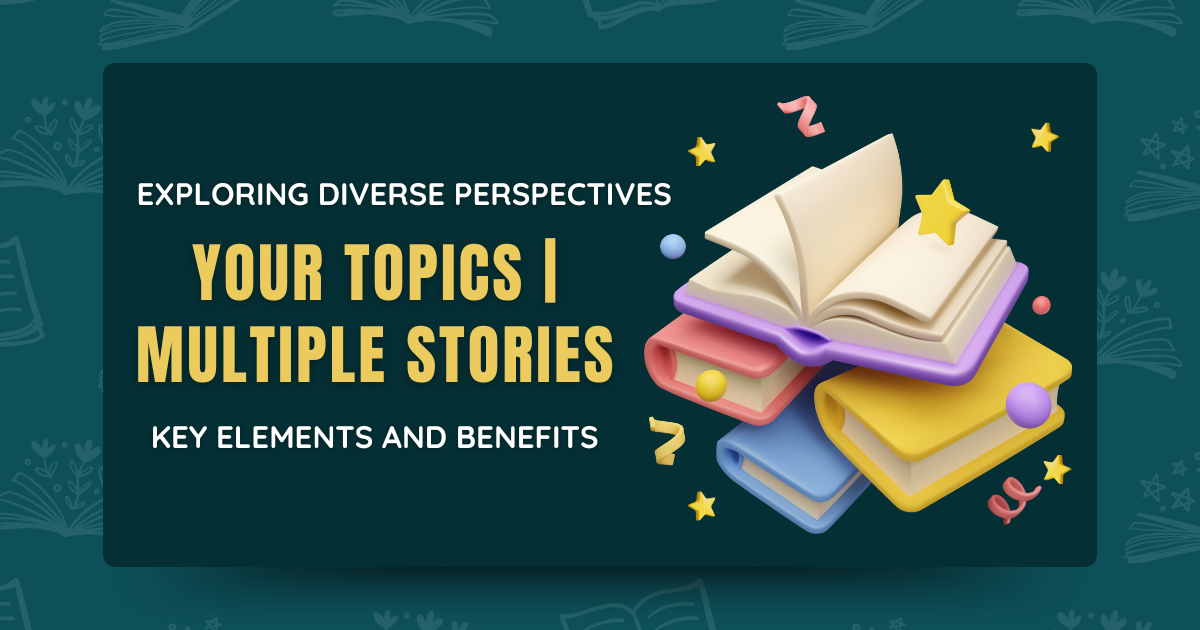“Your Topics | Multiple Stories” is a concept that encourages you to explore various aspects of a particular topic or theme through storytelling. Instead of focusing on a single narrative, you delve into multiple interconnected stories to provide a more comprehensive and engaging understanding of the subject matter.
Key Elements and Benefits
- Multiple Perspectives: By presenting different viewpoints or experiences, you can offer a more nuanced and balanced understanding of the topic.
- Depth and Complexity: Exploring multiple stories allows you to delve deeper into the intricacies and complexities of the subject matter.
- Engagement and Interest: A variety of stories can keep your audience engaged and interested, preventing boredom.
- Richness and Texture: Incorporating multiple narratives can add richness and texture to your storytelling, making it more memorable.
Example: “The Impact of Climate Change”

To illustrate this concept, let’s consider the topic of “The Impact of Climate Change.” Instead of focusing on a single case study or event, you could explore multiple stories:
- A farmer’s struggle with crop failures due to extreme weather.
- A coastal community facing rising sea levels and displacement.
- A scientist’s research on the effects of climate change on wildlife.
- A policymaker’s efforts to address climate change through sustainable initiatives.
- A personal story of someone who has changed their lifestyle to reduce their carbon footprint.
By weaving together these diverse stories, you can create a more compelling and informative narrative about the far-reaching consequences of climate change.
Tips for Using “Your Topics | Multiple Stories”
- Choose a Strong Theme: Select a topic that interests you and has multiple angles to explore.
- Identify Key Stories: Brainstorm different stories that relate to your theme and contribute to a broader understanding.
- Connect the Stories: Find ways to connect the individual stories to create a cohesive narrative.
- Consider Different Formats: Experiment with various storytelling formats, such as essays, short stories, interviews, or multimedia presentations.
By effectively utilizing “Your Topics | Multiple Stories,” you can create engaging and informative content that resonates with your audience and leaves a lasting impression.
Why “Your Topics | Multiple Stories” Matters
1. Promotes Understanding
When multiple narratives converge, they reveal the full spectrum of a topic. This helps readers form a holistic understanding and makes complex themes relatable.
2. Encourages Empathy
By highlighting diverse experiences, storytelling fosters empathy. Readers are more likely to connect with the subject when they see it from different perspectives.
3. Provides Richness and Texture
A collection of stories creates a layered narrative that is memorable and impactful, adding depth and texture to the storytelling.
How to Create Compelling Stories

1. Identify a Strong Theme
Choose a central topic that resonates with your audience. Ensure it has multiple angles to explore. For instance, consider themes like climate change, mental health, or technological innovation.
2. Curate Key Narratives
Brainstorm individual stories that contribute to the broader narrative. Ensure each story sheds light on a unique aspect of the theme.
Example: The Impact of Climate Change
- A farmer’s battle with unpredictable weather patterns.
- A community’s resilience against rising sea levels.
- A scientist’s breakthrough research on sustainable energy.
- A policymaker’s advocacy for green initiatives.
- A young activist’s efforts to inspire change.
3. Connect the Stories
While each narrative stands alone, find threads that bind them together. This connection creates a cohesive and seamless storytelling experience.
4. Leverage Diverse Formats
Experiment with storytelling mediums, including:
- Written formats: Essays, blogs, and articles.
- Visuals: Videos, infographics, and photo essays.
- Interactive formats: Podcasts, webinars, or virtual storytelling events.
Practical Applications Across Key Themes
1. Social Issues
Address critical challenges by including stories from different stakeholders. For example, when discussing mental health awareness:
- Share a therapist’s professional insights.
- Highlight a patient’s recovery journey.
- Explore the impact of mental health on workplaces and communities.
2. Environmental Advocacy
Present narratives from individuals, organizations, and policymakers working towards sustainable solutions. Showcase both struggles and triumphs to inspire action.
3. Technological Innovations
Highlight how technology affects various sectors:
- A startup founder’s success story.
- The challenges faced by rural communities in adopting new tech.
- Predictions from industry experts on future trends.
Case Study: Weaving Multiple Stories on Climate Change
1. Story One: A Farmer’s Struggles
Amid unpredictable rainfall, a farmer in India shares how climate change has disrupted agricultural practices. His story sheds light on the direct impacts of global warming on rural livelihoods.
2. Story Two: A Coastal Community’s Resilience
In the Maldives, a small community adapts to rising sea levels by embracing eco-friendly practices, such as building floating homes and implementing coral reef restoration projects.
3. Story Three: A Scientist’s Research
A climatologist explains how innovative carbon capture technologies could slow global warming. The research highlights the potential of science to mitigate long-term damage.
4. Story Four: A Policy Maker’s Initiative
A politician advocates for renewable energy policies, demonstrating how government intervention can accelerate sustainable development.
5. Story Five: A Personal Lifestyle Shift
A young activist shares their journey of transitioning to a zero-waste lifestyle, inspiring readers to make small but impactful changes.
Tips for Effective Storytelling Using This Approach
1. Tailor Content to Your Audience
Understand your readers’ preferences and interests. This ensures your stories resonate and keep them engaged.
2. Balance Fact and Emotion
Blend factual accuracy with emotional storytelling. This combination makes your narrative both informative and relatable.
3. Include Visual and Multimedia Elements
Enhance your stories with visuals that complement the text. Infographics, images, and videos can make your content more engaging.
Conclusion: A New Era of Storytelling
“Your Topics | Multiple Stories” is a groundbreaking approach that enriches content by exploring multiple angles of a single theme. Whether you’re addressing global challenges, sharing personal experiences, or advocating for change, this method creates compelling narratives that inform, inspire, and captivate audiences.
By embracing diverse perspectives, we can craft stories that not only resonate with readers but also leave a lasting impact on how they perceive the world.






